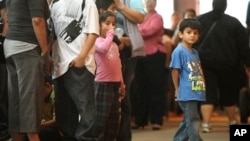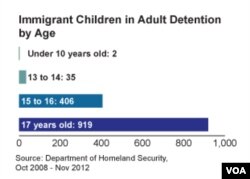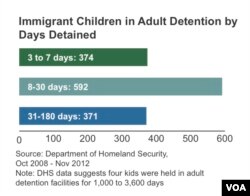WASHINGTON —
Newly released data from the Department of Homeland Security (DHS) suggests hundreds of immigrant children, unaccompanied and undocumented in the United States, have been held in adult detention centers, contrary to federal regulations.
The revelation comes as immigration authorities are grappling with an unprecedented rise in the number of youths illegally migrating to the U.S. from Latin America.
DHS detained at least 1,366 children in adult immigration facilities between 2008 and 2012, according to data released by the National Immigrant Justice Center this week.
The Chicago-based advocacy group obtained the data after a two-year legal battle with DHS.
The legal settlement required DHS to release data for just 30 of the approximately 250 immigration detention facilities whose services it contracts.
The National Immigrant Justice Center says the limited reporting suggests the number of children locked up with adults could be much higher.
"It’s a startling revelation,” said the center’s executive director, Mary Meg McCarthy. "These children were isolated from access to legal counsel and may have been denied protections under U.S. law. It’s beyond time for Congress to step in and hold DHS accountable for an immigration detention system that has gotten too big and out of control."
The findings come as Congress is drafting new legislation to manage the U.S. immigration system, including the rights afforded to undocumented foreigners being detained.
Currently, federal regulations require DHS to refer children under the age of 18 to the Department of Health and Human Service’s Office of Refugee Resettlement (ORR) within 72 hours of their apprehension. ORR is specifically tasked to work with unaccompanied immigrant children, placing the kids in a network of shelters offering mental and physical support, translators, recreational activities and family reunification services.
However, the DHS data shows more than 1,300 children were detained in adult facilities for more than three days. Across 13 states, approximately 390 undocumented immigrant minors were held for more than a month in county jails, detention centers and private prisons run by the Corrections Corporation of America. Of that number, 15 were held in adult detention facilities for more than three months, and four were detained for between 1,000 and 3,600 days.
Pushed from home
The data may speak to a larger issue. The number of immigrant children entering the U.S. by themselves is soaring, although border crossings overall have declined sharply in the last decade.
It’s difficult to pinpoint exactly how many foreigners - adults and children - are entering the U.S. illegally because the people coming in don’t announce their arrival. The best measure is data on apprehensions and detentions, which are also imprecise because of the many bureaucracies involved.
But ORR says one thing is clear: More kids are coming to the U.S. alone than ever before.
On average, ORR serves between 7,000 and 8,000 children annually. That number soared to 13,625 children in fiscal year 2012. By the end of this year, the office is expecting to have served 23,000 children.
And those are only the children referred to ORR by immigration authorities. The actual number may be much higher, as suggested by Customs and Border Patrol, which says its agents apprehended 31,029 juveniles in fiscal year 2012. Immigration and Customs Enforcement, another DHS branch, has not released its numbers.
Strained services
The influx has been so great that ORR has had to set up temporary emergency shelters to house children in gymnasiums and at an air force base.
The Office of Refugee Resettlement says the kids, most of them boys over 14 years old, are coming primarily from Guatemala, El Salvador, Honduras and Mexico. The ORR says gangs, drug cartels and poverty are pushing them from home.
Representatives from the Women’s Refugee Commission interviewed children at the emergency facilities last June and found kids who said that while in Border Patrol custody, they sometimes slept on crowded cement floors in facilities with no showers, where the lights stayed on 24 hours a day.
Jennifer Podkul, senior program officer at the Women’s Refugee Commission, said ORR was doing “the best it could” considering the circumstances and has since increased its number of beds and closed the emergency shelters.
But she said the strained situation her group was able to monitor raises questions about the situation it wasn’t able to monitor - children in adult immigration detention centers.
“I think this information was a surprise to people, and there’s still a lot of information we don’t know,” she said. “Why were they there? Were they misclassified or improperly screened? Was there a backup during a period when a lot of kids were coming in?”
Room for improvement
Podkul said the newly released DHS data is worrisome because it suggests the government has not been completely successful in improving the treatment of unaccompanied immigrant minors. As part of the 2002 Homeland Security Act, the U.S. government separated the duties of immigration authorities who were once tasked with apprehending and prosecuting kids, and with taking care of them.
Podkul acknowledged the government’s efforts to improve the situation for immigrant children, but she said more work is needed.
“The government has to be more careful with children - they need to make sure they’re being held in the appropriate facilities,” she said. “Even if it’s a border patrol station, they still need to make sure there’s special conditions."
DHS did not respond to requests for comment. But Immigration and Customs Enforcement (ICE) said in a statement it takes seriously its responsibility to care for unaccompanied immigrant children in the U.S. illegally.
“It is against ICE policy to detain an unaccompanied minor for more than 72 hours and in no instance will an unaccompanied minor be housed in an ICE detention facility while awaiting transfer to [Health and Human Services],” the statement said. “Unaccompanied minors are carefully kept in staging facilities away from the general population and minors are only held in ICE custody when accompanied by their parents in a facility designed to house families.”
The revelation comes as immigration authorities are grappling with an unprecedented rise in the number of youths illegally migrating to the U.S. from Latin America.
DHS detained at least 1,366 children in adult immigration facilities between 2008 and 2012, according to data released by the National Immigrant Justice Center this week.
The Chicago-based advocacy group obtained the data after a two-year legal battle with DHS.
The legal settlement required DHS to release data for just 30 of the approximately 250 immigration detention facilities whose services it contracts.
The National Immigrant Justice Center says the limited reporting suggests the number of children locked up with adults could be much higher.
"It’s a startling revelation,” said the center’s executive director, Mary Meg McCarthy. "These children were isolated from access to legal counsel and may have been denied protections under U.S. law. It’s beyond time for Congress to step in and hold DHS accountable for an immigration detention system that has gotten too big and out of control."
The findings come as Congress is drafting new legislation to manage the U.S. immigration system, including the rights afforded to undocumented foreigners being detained.
Currently, federal regulations require DHS to refer children under the age of 18 to the Department of Health and Human Service’s Office of Refugee Resettlement (ORR) within 72 hours of their apprehension. ORR is specifically tasked to work with unaccompanied immigrant children, placing the kids in a network of shelters offering mental and physical support, translators, recreational activities and family reunification services.
However, the DHS data shows more than 1,300 children were detained in adult facilities for more than three days. Across 13 states, approximately 390 undocumented immigrant minors were held for more than a month in county jails, detention centers and private prisons run by the Corrections Corporation of America. Of that number, 15 were held in adult detention facilities for more than three months, and four were detained for between 1,000 and 3,600 days.
Pushed from home
The data may speak to a larger issue. The number of immigrant children entering the U.S. by themselves is soaring, although border crossings overall have declined sharply in the last decade.
It’s difficult to pinpoint exactly how many foreigners - adults and children - are entering the U.S. illegally because the people coming in don’t announce their arrival. The best measure is data on apprehensions and detentions, which are also imprecise because of the many bureaucracies involved.
But ORR says one thing is clear: More kids are coming to the U.S. alone than ever before.
On average, ORR serves between 7,000 and 8,000 children annually. That number soared to 13,625 children in fiscal year 2012. By the end of this year, the office is expecting to have served 23,000 children.
And those are only the children referred to ORR by immigration authorities. The actual number may be much higher, as suggested by Customs and Border Patrol, which says its agents apprehended 31,029 juveniles in fiscal year 2012. Immigration and Customs Enforcement, another DHS branch, has not released its numbers.
Strained services
The influx has been so great that ORR has had to set up temporary emergency shelters to house children in gymnasiums and at an air force base.
The Office of Refugee Resettlement says the kids, most of them boys over 14 years old, are coming primarily from Guatemala, El Salvador, Honduras and Mexico. The ORR says gangs, drug cartels and poverty are pushing them from home.
Representatives from the Women’s Refugee Commission interviewed children at the emergency facilities last June and found kids who said that while in Border Patrol custody, they sometimes slept on crowded cement floors in facilities with no showers, where the lights stayed on 24 hours a day.
Jennifer Podkul, senior program officer at the Women’s Refugee Commission, said ORR was doing “the best it could” considering the circumstances and has since increased its number of beds and closed the emergency shelters.
But she said the strained situation her group was able to monitor raises questions about the situation it wasn’t able to monitor - children in adult immigration detention centers.
“I think this information was a surprise to people, and there’s still a lot of information we don’t know,” she said. “Why were they there? Were they misclassified or improperly screened? Was there a backup during a period when a lot of kids were coming in?”
Room for improvement
Podkul said the newly released DHS data is worrisome because it suggests the government has not been completely successful in improving the treatment of unaccompanied immigrant minors. As part of the 2002 Homeland Security Act, the U.S. government separated the duties of immigration authorities who were once tasked with apprehending and prosecuting kids, and with taking care of them.
Podkul acknowledged the government’s efforts to improve the situation for immigrant children, but she said more work is needed.
“The government has to be more careful with children - they need to make sure they’re being held in the appropriate facilities,” she said. “Even if it’s a border patrol station, they still need to make sure there’s special conditions."
DHS did not respond to requests for comment. But Immigration and Customs Enforcement (ICE) said in a statement it takes seriously its responsibility to care for unaccompanied immigrant children in the U.S. illegally.
“It is against ICE policy to detain an unaccompanied minor for more than 72 hours and in no instance will an unaccompanied minor be housed in an ICE detention facility while awaiting transfer to [Health and Human Services],” the statement said. “Unaccompanied minors are carefully kept in staging facilities away from the general population and minors are only held in ICE custody when accompanied by their parents in a facility designed to house families.”


